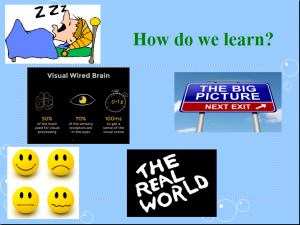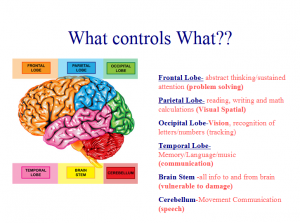Earlier this year, I did a professional development session with the teacher assistants on how our students learn math and why it is difficult for some of our students. Yesterday, I read an online article by Anna Christiansen and PBS News Hour entitled, “Why Is Math Easier for Some Kids Than Others?” I have always been intrigued with how the brain works and how we code information while learning—this article helped me make some connections to things I had read previously. Today’s blog entry will focus on my process of new information and sharing it with you to not only deepen my learning but maybe to open up your thinking to some “Why’s” behind methods we use and their effectiveness.
To set the stage, remember that every brain is unique and how you code and retrieve information is different from someone else. What we do have in common is the “layers” of the brain and the “sections” of our brains. The composition and organization is similar but rates, abilities, strengths, preferences and weaknesses are all one of a kind to you!
 Some things that we all have in common:
Some things that we all have in common:
1. Our brain needs 8 hours of sleep even if you think you do not. It is the time that your brain sorts information from the day and puts information into long term or short term memory. If you are not sleeping, this is not happening as it should.
2. Our emotional state not only affects our learning but if our basic needs are not met or we are in an anxious/tense state, information we are learning will not be properly coded or retrieved.
3. 50% of our learning happens visually. 70% of our sensory receptors are in our eyes. Once a symbol (letter/number) is truly coded and learned, it takes 0.15 seconds for our brain to process the meaning and 0.10 seconds to attach the meaning. So, in less than a quarter of a second your brain can look at a symbol and make meaning of it. (See the importance of automaticity?)
4. We have 5 times more information shown to us then we did in 1985. It is almost visual/information overload. On average, we only read about 28% of a website we look at. Think about how this affects our students looking at an EOG passage (without visuals) The visuals help to make meaning of the text but also to keep us focused to the text.
5. Some of us process information better by having information presented in small parts which lead to the big picture where others prefer to have the big picture presented and then for it to be broken into smaller sequential pieces. It is important for teachers to provide both–share with students The Big Picture and then the road map (progression of steps) or you will lose part of your audience before you begin.
 Our brains are organized in a similar fashion with the following diagram explaining what controls which part of learning. To highlight the reason this is important to math, notice that the area that controls the learning of reading and language mainly is in the Parietal Lobe which is one area of the brain. In Math things are a bit more complex because learning of numbers as symbols takes place in the Occipital Lobe because they have to decipher the symbols. Students then use the Parietal Lobe for math calculations but when the problem requires problem solving they have to use the Frontal Lobe for their thinking. In addition, if we use learning styles and use music, dance or movement they may also be required to use the Temporal Lobe. The reason I share this is–if we are teaching something— for the student to retrieve it–they must have similar conditions, processes OR a cue to know where this information was coded (with language/calculations/problem solving). When we hear about teaching something conceptually–we also have to remember that we must teach it so that it is fluent (automatic) OR that the information has been coded in long term memory and easily retrievable. So, the procedural fluency is a HUGE piece to remember.
Our brains are organized in a similar fashion with the following diagram explaining what controls which part of learning. To highlight the reason this is important to math, notice that the area that controls the learning of reading and language mainly is in the Parietal Lobe which is one area of the brain. In Math things are a bit more complex because learning of numbers as symbols takes place in the Occipital Lobe because they have to decipher the symbols. Students then use the Parietal Lobe for math calculations but when the problem requires problem solving they have to use the Frontal Lobe for their thinking. In addition, if we use learning styles and use music, dance or movement they may also be required to use the Temporal Lobe. The reason I share this is–if we are teaching something— for the student to retrieve it–they must have similar conditions, processes OR a cue to know where this information was coded (with language/calculations/problem solving). When we hear about teaching something conceptually–we also have to remember that we must teach it so that it is fluent (automatic) OR that the information has been coded in long term memory and easily retrievable. So, the procedural fluency is a HUGE piece to remember.
So finally, to the article, “researchers at Stanford University of Medicine found that when students begin processing mental math, the brain reorganizes itself to use its short-term center the hippocampus.” (Did you make a connection here to the above paragraph??) To me this means, that students are using two different parts of the brain for procedure and memory retrieval. If they are skip counting because they have not learned their facts–they can figure the answer out BUT it will be bigger struggle for the student because they will have to access two sections of the brain. The more procedure we can do to make it “fluent” the better. This confirms with research the need for students to be automatic with facts and basic knowledge. Mann Koepke (2009) of NIH, states, “…the child’s brain does not have to labor over simple math, there is more short-term memory space to learn new concepts, so they catch on earlier and faster.”
In conclusion, conceptual understanding is important to build the child’s ability to make connections and problem solve. Moving students as they practice strategy based math to the point of automaticity or fluency is crucial to strong math problem solvers. This confirms many of you who have said, they need to memorize their facts–yes, they do. In the meantime, continue to give them the strategies and procedures to figure it out. We cannot go back to just memorization or turn and run completely to the other extreme–it is about balance. The good news is that Engage NY is combining these concepts with both procedural fluency and conceptual understanding. I hope this gives you a “bit of why” or the research behind the things we do and how it affects student learning!
Resources
brain math PowerPoint used with teacher assistants